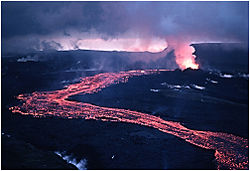Iceland hotspot
2008/9 Schools Wikipedia Selection. Related subjects: Geology and geophysics

The Iceland hotspot is a hotspot which is partly responsible for the high volcanic activity which has formed the island of Iceland.
Description
Iceland is one of the most active volcanic regions in the world, with eruptions occurring on average roughly every five years. About a third of the basaltic lavas erupted in recorded history have been produced by Icelandic eruptions. Notable eruptions have included that of Eldgjá in 984 (the world's largest basaltic eruption ever witnessed), Laki in 1783 (the world's second largest), and several eruptions beneath ice caps, which have generated devastating glacial bursts, most recently in 1996.
Iceland's location astride the Mid-Atlantic Ridge, where the Eurasian and North American Plates are moving apart, is partly responsible for this intense volcanic activity, but an additional cause is necessary to explain why Iceland is a substantial island while the rest of the ridge mostly consists of seamounts, with peaks below sea level.
As well as being a region of higher temperature than the surrounding mantle, it is also believed to have a higher concentration of water. The presence of water in magma reduces the melting temperature, and this may also play a role in enhancing Icelandic volcanism.
Theories of causation
There is an ongoing discussion whether the hotspot is caused by a deep mantle plume or originates at a much shallower depth.
Some geologists have questioned whether the Iceland hotspot has the same origin as other hotspots such as the Hawaii hotspot. While the Hawaiian island chain and the Emperor Seamounts show a clear time-progressive volcanic track caused by the movement of the Pacific Plate over the Hawaiian hotspot, no such track can be seen at Iceland.
Mantle plume theory
It is believed that a mantle plume underlies Iceland, of which the hotspot is thought to be the surface expression. This enhances the volcanism already caused by plate separation, both at the centre of the island and at the Reykjanes ridge to the southwest of Iceland's main volcanic zone. The plume is believed to be quite narrow, perhaps 100 km across, and extends down to at least 400–650 km beneath the Earth's surface, and possibly down to the core-mantle boundary.
Studies suggest that the hotspot is only 50-100 K hotter than its surroundings, which may not be a great enough difference to drive a buoyant plume.
It is suggested that the lack of a time-progressive track is because the plume may have been located beneath the thick Greenland craton for a significant time.